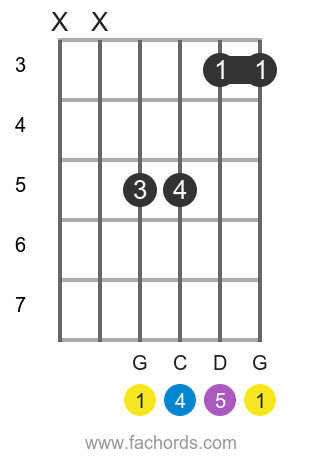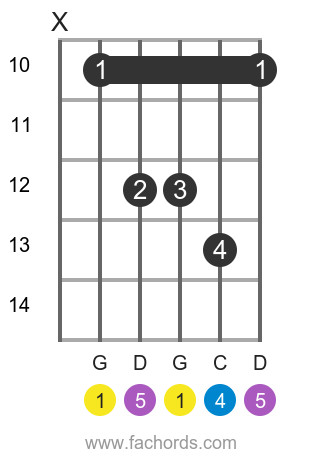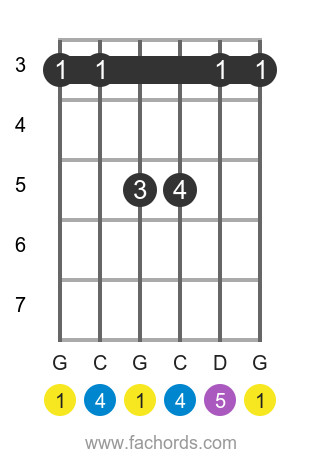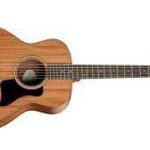The Gsus4 guitar chord is a captivating and widely used chord that adds a unique flavor to both rhythm and lead guitar playing. As a type of suspended chord, the Gsus4 replaces the major or minor third with a perfect fourth, creating an open, airy sound that’s neither strictly major nor minor. This makes it a fantastic chord for creating harmonic interest and smooth transitions in your guitar progressions.
In this guide, we’ll explore everything you need to know about the Gsus4 chord. We’ll cover its construction, different ways to play it across the fretboard, and how to effectively use it in your music. Whether you’re just starting your guitar journey or looking to expand your chord vocabulary, understanding the Gsus4 is a valuable step.
Understanding the Notes and Theory Behind the Gsus4 Chord
The Gsus4 chord is built from three fundamental notes:
- G – the Root (1)
- C – the Perfect Fourth (4)
- D – the Perfect Fifth (5)
These intervals – Root, Perfect Fourth, and Perfect Fifth – are what define the suspended fourth chord. The absence of the third degree (either major or minor) is what gives the sus4 chord its characteristic ambiguous and unresolved quality. Compared to a standard G major chord (G, B, D) or G minor chord (G, Bb, D), the Gsus4 offers a distinct sonic texture.
If you’re interested in delving deeper into the theory behind chord construction, exploring resources on guitar music theory and fretboard intervals can be highly beneficial. And for a broader understanding of different chord types, our comprehensive guide to guitar chords is a great resource.
Exploring Gsus4 Chord Positions on the Guitar Fretboard
The Gsus4 chord can be played in various positions across the guitar fretboard, each offering a slightly different tone and feel. Here are some of the most common and useful positions:
Position 1: Open Gsus4 Chord
 G sus4 open position chord diagram, easy guitar chord for beginners
G sus4 open position chord diagram, easy guitar chord for beginners
This is the most common and easiest way to play the Gsus4 chord, especially for beginners. It’s an open chord position, meaning it utilizes open strings.
- Fingering:
- Index finger: 1st fret of the E string (Fret 1, String 6)
- Middle finger: 2nd fret of the A string (Fret 2, String 5)
- Ring finger: 3rd fret of the E string (Fret 3, String 1)
- Strumming: Strum all six strings.
This open position Gsus4 is bright and resonant, making it ideal for folk, pop, and rock music.
Position 2: Barre Chord Gsus4 (Position 2 Shape)
 G sus4 barre chord diagram position 2, movable guitar chord shape
G sus4 barre chord diagram position 2, movable guitar chord shape
This Gsus4 position is a movable barre chord shape rooted on the 6th string.
- Fingering:
- Barre your index finger across the 3rd fret (all six strings).
- Ring finger: 5th fret of the A string (Fret 5, String 5)
- Pinky finger: 5th fret of the D string (Fret 5, String 4)
- Strumming: Strum all six strings.
Being a barre chord, this shape can be moved up and down the neck to create other sus4 chords with different roots. For example, moving this shape up two frets would create an Asus4 chord. If you’re finding barre chords challenging, our Bar Chords Tips tutorial offers helpful guidance.
Position 3: Barre Chord Gsus4 (Position 3 Shape)
 G sus4 barre chord diagram position 3, alternative guitar chord voicing
G sus4 barre chord diagram position 3, alternative guitar chord voicing
Another movable barre chord shape, this position is rooted on the 5th string.
- Fingering:
- Barre your index finger across the 5th fret (strings 1-5).
- Ring finger: 7th fret of the D string (Fret 7, String 4)
- Pinky finger: 7th fret of the G string (Fret 7, String 3)
- Strumming: Strum strings 5, 4, 3, 2, and 1. Avoid strumming the low E string.
This position offers a slightly different voicing of the Gsus4 chord, often sounding a bit warmer than the open position.
Position 4: Barre Chord Gsus4 (Position 4 Shape)
 G sus4 barre chord diagram position 4, common guitar chord fingering
G sus4 barre chord diagram position 4, common guitar chord fingering
This is a variation of the barre chord, again movable and rooted on the 6th string, but with a different fingering.
- Fingering:
- Barre your index finger across the 3rd fret (all six strings).
- Middle finger: 4th fret of the G string (Fret 4, String 3)
- Ring finger: 5th fret of the A string (Fret 5, String 5)
- Pinky finger: 5th fret of the D string (Fret 5, String 4)
- Strumming: Strum all six strings.
This shape provides a fuller sound and is a commonly used voicing for the Gsus4 chord in many genres.
For even more Gsus4 chord shapes and voicings, you can explore our all guitar chords library. And if you prefer a handy reference guide, download our Free Guitar Chords Chart Pdf.
Utilizing the Gsus4 Chord in Your Music
The Gsus4 chord is incredibly versatile and can be used in various musical contexts. Here are a few common applications:
- Suspension and Resolution: Gsus4 often functions as a suspension resolving to a G major or G minor chord. The movement from Gsus4 to G creates a satisfying harmonic resolution.
- Adding Harmonic Color: In chord progressions, Gsus4 can add a touch of complexity and interest without drastically changing the overall key.
- Intros and Outros: The open, airy quality of Gsus4 makes it a great choice for intros and outros, creating a sense of anticipation or lingering resonance.
- Pop and Rock Ballads: Gsus4 is frequently used in ballads and softer rock songs to add emotional depth and dynamics.
Experiment with incorporating the Gsus4 chord into your own songs and progressions. You can also explore other sus4 chords, such as Csus4, Dsus4, Esus4, Fsus4, Asus4, and Bsus4 to further expand your sonic palette.
Conclusion
The Gsus4 guitar chord is a valuable addition to any guitarist’s toolkit. By understanding its construction and practicing these different positions, you’ll be able to enrich your playing and add a unique harmonic dimension to your music. So, take some time to learn these shapes, experiment with their sound, and discover how the Gsus4 chord can enhance your guitar playing journey!

